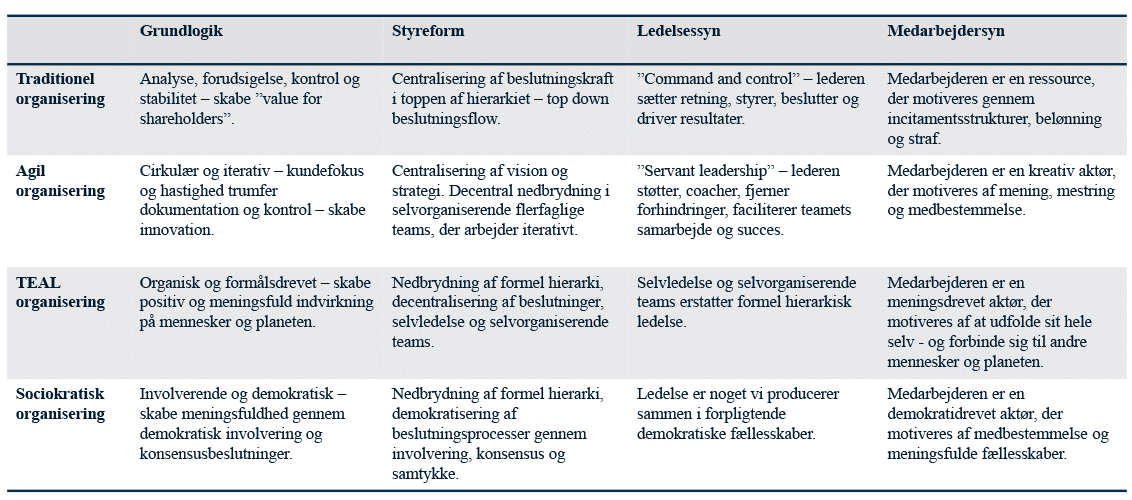Agile, teal and sociocracy. There are many different terms for the new, less hierarchical and more human forms of organization that are emerging in recent years. What these forms of organizing have in common is that they try to evoke and highlight the best that employees and managers can do together by empowering rather than controlling them. Therefore, these organizational forms can be an important tool to combat unhappiness and stress in Danish organizations. In this article, we explore how the basic features of new organizational forms can potentially help improve wellbeing.
From a well-being perspective
The new organizational forms are particularly interesting to examine from a well-being perspective for three reasons:
1
The prevalence of stress, unhappiness and burnout continues to rise. Both managers and organizations need to address this (Sundhedsstyrelsen, 2022).
2
More employees want more flexibility and a clearer purpose for their work - a trend that new forms of organization can help meet (Deloitte, 2023).
3
With labor shortages in both the public and private sectors, top leaders need to think deeply about how their organizations can attract, connect and adapt to the new conditions (The Attractive Workplace, 2024).
These challenges with wellbeing, attraction and attachment lead to a fundamental question: Is there something wrong or inappropriate in the way we organize ourselves in Denmark? The fact is that stress and unhappiness has not improved in recent years, despite a growing focus. On the contrary, it has only gotten worse. Many people estimate that they get stressed and burnt out from going to work. Of course, no one wants this to be the case, but it's hard to change the problem.
A potentially overlooked place to work on improving wellbeing and reducing stress is in the organization of work itself. Far too few have looked at organizing for better wellbeing and thus promoting a more attractive workplace that attracts and retains employees and managers. And that's a shame, because there is hidden potential here.
Similarities and differences between new organizational forms
Common to the new forms of organizing is that they emphasize people over processes and procedures. The core question of traditional organizational forms is: "How do we manage people to fulfill the organization's purpose?", while the core question of the new humanocratic organizational forms is: "Which organization evokes and values the best that human beings can present?" (Hamel & Zanini, 2021, p. 51).
The new forms of organization are therefore based on the human being, in the sense that they want to make room for influence and to release human potential and abilities. Organizational forms can be part of the solution to the well-being and attraction challenges because they seek to set people more free through meaning, mastery and co-determination, which are basic needs for human motivation and well-being (Pink, 2011). In this way, organizations are shaped by approaches that strengthen motivation and well-being.
Organizational forms
The following model outlines the differences and similarities between some of the most common new forms of organizing compared to the classic hierarchical approach to organizing:
In both theory and practice, the new organizational forms differ in many ways, but they also share a number of common characteristics, such as an increased focus on purpose, creating value across multiple bottom lines, flatter hierarchies with fewer formal leadership roles and more distributed leadership responsibilities, and greater connectedness and focus on collaboration in self-organizing and often multidisciplinary teams (Østergaard, 2020).
The pragmatic approach
Few organizations adopt one new way of organizing in its purest form. Instead, most who experiment with organizing differently take a pragmatic approach, taking the 'best of both worlds' and adapting to their own context.
Perhaps that's why many people working to introduce new organizational forms succeed in identifying the factors and conditions that need to be present for employees to thrive and perform. Six factors are often highlighted. They are called "the six golden nuggets" (Andersen & Kingston, 2016) and are:
1
Influence: Influence or be involved in important decisions in your own work such as direction, prioritization, planning and the practical execution of the work.
2
Meaning: Being able to clearly see how one's own task solution affects or plays into a larger and meaningful purpose, thereby creating value for others.
3
Social support: Colleagues, teams and managers care about and support each other.
4
Reward: Constructive feedback and recognition so that work is appreciated and it's clear that others find the effort valuable. Salary, career opportunities and promotion also play an important role.
5
Requirements: Must be clear and transparent, and it must be clear when the work has been completed sufficiently. In addition, tasks should be balanced so that they are neither too difficult nor too easy, but stimulating.
6
Predictability: Knowing what's happening and when it's happening so you feel in control of your work.
The potential of new forms of organization
The six golden nuggets are far from always present in today's organizations. This is hardly surprising. Daniel Pink, for example, points out in his book "Drive" (2011) that there is a big difference between how much is known about what it takes to create workplaces where employees thrive and perform and what actually happens in organizations.
In recent years, a growing number of theorists have begun to explore whether one of the main reasons for this discrepancy lies in the way we organize ourselves (Dignan, 2019; Minnaar & Morree, 2019). It is worth looking at how the commonalities of the new forms of organization can act as a lever to improve wellbeing at work, because the six golden nuggets can potentially be reflected in the new forms of organization:
Empowerment and self-determination
Across the new organizational forms, an important starting point is to create a high degree of influence across the organization. This is partly about being involved in key decision-making processes and partly about the employee having greater influence on the execution and organization of work (Østergaard, 2020). This can be seen in agile working methods, where the team jointly prioritizes the tasks they consider most important to create value for the customer. It is then up to the self-organized team to figure out who does what and how best to organize the work process (Rietze & Zacher, 2022). In more Teal-inspired organizations, a team with expertise in, for example, elderly care, will decide how to provide the best support and care based on their professional judgment (Burkus, 2016).


Social support and shared responsibility
In the new organizational forms, teams are often the central and supporting element, while departments, formal management and organizational boundaries are downplayed. The team as the core element means that responsibility is placed in the team, who must work together to fulfill this responsibility or purpose. The distribution and execution of tasks is not dictated by managers or individual top performers. This can potentially create a better balance in the demands and predictability of the work, as tasks are distributed by the team itself. There is greater co-determination over who does which tasks, which can lead to greater predictability (Rietze & Zacher, 2022). The strong focus on the team can potentially create a greater focus on succeeding together. This approach will often increase feelings of social support as the team solves tasks as a working community (Gray et al., 2015).
Meaning and clear purpose
In teal-inspired organizations, purpose is the clearest guidepost. Employees have a strong influence in defining how they can most meaningfully work towards the organization's purpose. Laloux (2015) points out that purpose and goals are continuously renegotiated so that employees can see themselves in them - and thus they will have a natural motivation to achieve the purpose and live the values that the goals dictate. In an agile context, it is hypothesized that individuals can more easily see the meaning in even the smallest tasks when working iteratively with small deliverables that are continuously tested and evaluated against the larger, long-term purpose (Rietze & Zacher, 2022).


Learning and development
In many of the new organizational forms, learning, development and professional sparring are embedded in the organizational rhythm. For example, agile working methods include a large number of learning and reflection sessions aimed at improving both the product and the collaboration. This creates a space and framework for feedback and learning on a daily basis, which can meet the need to be recognized, but also to feel competent and develop (Rietze & Zacher, 2022). The same is seen in teal and sociocracy, where learning and adaptation in terms of both task performance and organizational form helps to improve and develop both task performance and the framework for it. This can potentially benefit the development and well-being of employees as well as the organization, which continuously adapts to the work (Laloux, 2015).
Dilemmas, challenges and pitfalls
The common features of the new organizational forms have the potential to promote well-being and prevent unhappiness and stress in Danish organizations and thus create more attractive workplaces. What they have in common is that they are based on trust in human competencies and decisions and emphasize interaction, learning and interaction over control, management and authority. The new organizational forms' focus on self-organizing teams, clearer meaning and purpose in work, learning and development and flatter hierarchies can help promote a focus on influence, social support, greater predictability and balanced demands in working life, all of which are positive factors in creating well-being (Klitgaard & Clausen, 2010).
However, it's important to be aware that the potential for wellbeing that new organizational forms offer does not mean that we are dealing with perfect organizations.
There are plenty of internal issues, potential conflicts, dilemmas, pitfalls and embedded challenges associated with new organizational forms. For this reason, it makes perfect sense to be careful not to implement all or part of these organizational or working forms until it's clear what the purpose is - and how they can be adapted to the specific organization, employees and culture that shapes and influences the organization as much as the organization itself does.
Andersen, M. F. & Kingston, M. (2016. Stop stress - handbook for managers. Klim. 1st edition.
Burkus, D. (2016).Under new management: the unexpected truths about leading great organizations. Pan Macmillan. 1st edition.
Bramming, P., & Andersen, V. (2019). Self-leading organization. News from the Social Sciences. 1st edition.
Deloitte (2023). 2023 Global Human Capital Trends. New Fundamentals for a Boundaryless World.
Dignan, A. (2019).Brave new work: Are you ready to reinvent your organization? Penguin Books. 1st Edition.
Gray, B. H., Sarnak, D. O., & Burgers, J. S. (2015).Home care by self-governing nursing teams: The Netherlands' Buurtzorg Model. New York: Commonwealth Fund.
Hamel, G., & Zanini, M. (2021).Humanocracy - fight bureaucracy and empower employees. Djøf Forlag. 1st edition. 1. Edition.
Kjellberg, P.K (2021). Experiments with the Buurtzorg model in Ikast-Brande Municipality. VIVE. The National Center for Welfare Research and Analysis. Mid-term evaluation of the Local Care trial in Bording-Engesvang.
Laloux, F. (2015).Reinventing organizations. A Guide to Creating Organizations Inspired by the Next Stage of Human Consciousness. Nelson Parker. 1st Edition.
Minnaar, J., & de Morree, P. (2020).Corporate Rebels: Make work more fun. Corporate Rebels Pub. 1. edition.
Rietze, S., & Zacher, H. (2022) Relationships between Agile Work Practices and Occupational Well-Being: The Role of Job Demands and Resources. Environ. Public Health.
Danish Health Authority (2022). The health of the Danes. The National Health Profile 2021.
Pink, D. (2011). Drive - the surprising truth about what motivates us. Penguin LCC US. 1st edition.
Østergaard, E. H (2020).Teal dot in an orange world - how to organize the workplace of the future. Lid Publishing Limited. 1. Edition.



